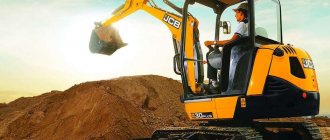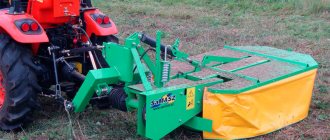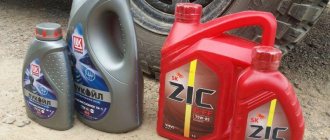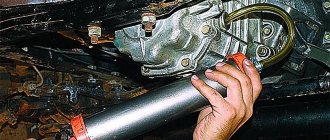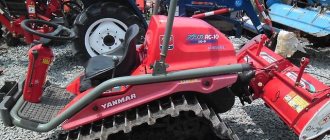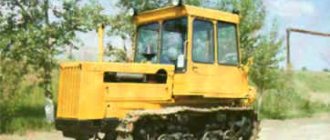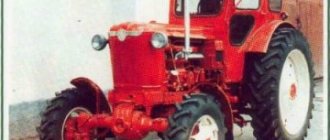The T-16 self-propelled tractor chassis is one example of a vehicle that has received wider use than the developers originally planned.
This tractor was produced from 1961 to 1967 for agricultural work. Its main functions were spraying, plowing the soil, cultivating crops, hilling, weed control, and harvesting.
For greater functionality, the SS had front mounts for installing a variety of additional equipment - cultivators, sprayers, row-crop and harvesting machines, saws, grader shovels, etc. All of them were driven by a power take-off shaft, that is, by transmitting torque from the tractor to the attachment. This means that the vehicle was developed as a powerful vehicle with high cross-country ability and reliability.
That is why the tractor was able to find application in other areas of the economy - it was actively used in construction to deliver building materials and drive construction mechanisms. In fact, the relatively small, compact T-16 was able to do the work of a truck, while its maneuverability and functionality were much higher.
Even half a century after the end of production of the T-16, the vehicles continue to serve and be modernized. The self-propelled chassis has become a rarity, and experts consider it a symbol of a high-quality, multi-purpose vehicle.
Tractor T-16 with modern tuning
Is it worth taking the T-16?
I have 15 hectares of open ground vegetables, I have a YuMZ tractor.
There is an opportunity to take a used T-16. Tell me, is it difficult to find spare parts for it, is it possible to remake attachments (cultivator, planter, etc.). so that it can be combined with the T-16, since we are unlikely to find special equipment for this tractor. and how is the tractor itself generally maintained and operated? In my opinion, the T-16 is crap. The two-cylinder engine works, don’t understand how (the exhaust is like a Lada on two cylinders), it’s weak, you’ll hardly find any units for it, and remaking, for example, MTZ’s is a hemorrhoid. Although, apparently he can do something, after all, it’s a miracle. Better yet, T-25. or a full-fledged minik with all the aggregates.
The question is the price. The T-16 is quite suitable as a delivery vehicle, but with the rest (mounted) there is a lot of hassle.
There is a topic on the T16, I advise you to read it, there are a lot of homemade products on it. I operate a tractor made in 1986 (I took it from the farm in 1994. During its operation, I repaired the engine, replaced the clutch, and the reverse gear. The tractor is indispensable for vegetable growing. In fact, it was designed for vegetable growing. The front position of the frame gives a lot of room for imagination. It is very convenient to cultivate when the cultivator is located in front, convenient for transporting vegetables from the field.
There is a topic on the T16, I advise you to read it, there are a lot of homemade products on it. I operate a tractor made in 1986 (I took it from the farm in 1994. During its operation, I repaired the engine, replaced the clutch, and the reverse gear. The tractor is indispensable for vegetable growing. In fact, it was designed for vegetable growing. The front position of the frame gives a lot of room for imagination. It is very convenient to cultivate when the cultivator is located in front, convenient for transporting vegetables from the field.
Yes, I have a trailer for transportation. I'll look into the topic. Thank you. for a tractor they are asking 60,000 rubles. this is with a mower. plus for extra They offer a fee for a loader and a knife. I haven't seen it yet, maybe I'll go and have a look tomorrow
Anyone who, instead of one ear or one stalk of grass, manages to grow two in the same field, will render a greater service to humanity and his homeland than all politicians taken together. (Jonathan Swift)
If I understand correctly, this is about 2 thousand dollars? If it is in good condition, take it and you won’t regret it.
In my opinion, the T-16 is crap. The two-cylinder engine works, don’t understand how (the exhaust is like a Lada on two cylinders), it’s weak, you’ll hardly find any units for it, and remaking, for example, MTZ’s is a hemorrhoid. Although, apparently he can do something, after all, it’s a miracle. Better yet, T-25. or a full-fledged minik with all the aggregates.
I fundamentally disagree with your opinion. You need to start with what you actually need a tractor for. Personally, I have had a T-16 for more than 15 years. An extremely reliable device and economical. We use it on the farm to transport all sorts of cargo and transport a light trolley. You can easily attach a water pump to it (using the front PTO) or a single bar. Finding trailed units for it is problematic if you don’t buy new ones.
tractor t-16
Hello. Is there anyone who operates the T-16 tractor?
And what kind of mounted, trailed and other interesting things are there! I have owned the T-16 for several years, but, to my shame, I only use it as a cart with a motor :) But it turns out that you can hang a lot of things on it. I recently found out how to make a front loader, I'm going to do it in the spring.
The beginning of wisdom is the fear of the Lord, and the knowledge of the Holy One is understanding; Proverbs 8:10
I'm new to this topic. but in the village we have 10 T-16s working and only 3 T-25s. For haymaking there is no better machine than the T-16
I have a 16 t, I use it as a loader-excavator, it’s been with me for 15 years. At first I tried it as a row crop, it’s extremely inconvenient. Well, just mowing, but as an excavator, that’s it.
Is the excavator homemade? Can I have a photo?
The beginning of wisdom is the fear of the Lord, and the knowledge of the Holy One is understanding; Proverbs 8:10
The fifth year has begun. From a mounted lift, a shovel, a box, a trailer. This year I’m going to make a milling cutter, a digger, and a tops mower - before this year there was no need. Files: imgp2250.jpg
Good day, owners of T-16 and more. I have had this tractor for 1 year now. I overdid the goner. Sabral I'm conducting tests. I want to make a canopy.
Now I’m also making a hitch.
I want to do the hitch something like this. the basis is already there. there are still thigh extensions and cylinders Files: img_1206_0.jpg dscn2319_0.jpg dscn2317.jpg
here is a simple front loader. The quality of the photos is not very good (screenshots of the video from YouTube) Files: 10_11.jpg 8_16.jpg
Does anyone have a plow for the T-16?
Hello. Is there anyone who operates the T-16 tractor?
the plow that is hung on the shank in front is called PKSh-30. Unfortunately, when searching, I can’t find its design and price anywhere
About the plow. In Odessa they make not only a plow for the chassis, but also much more, you can look at the link. There are also telephone numbers of representatives in Moscow https://www.avtomash.ru/pred/odessa/prh225.htm
However, I myself need a mower attachment diagram. Not the one they are making now, but for the old KSF-2.1. M.b. who has it - please share
Here's something off the net
The bottom photo shows a cool loader. More precisely, a link or photo of the nodes cannot be provided. This is a very interesting option when you are on your own. Mounting units, cylinder connections, etc. M.b. who has?
Wonderful T-16 technology, I really like it, but for some reason we have almost none of them. Are they generally expensive? Or rare? Are there spare parts for them?
Wonderful T-16 technology, I really like it, but for some reason we have almost none of them. Are they generally expensive? Or rare? Are there spare parts for them?
Yes, they seem to still be in production. Even in the same form as a hundred years ago. Respect to the manufacturers of Russian equipment - they respect ancient traditions. But seriously - the technology is super, there are just a lot of shortcomings, but you can ignore them or redo them yourself.
Where to buy and how to choose?
The price range is quite large and here you need to decide what you want to buy. An ideal restored tractor for 200-250 thousand rubles . Or for restoration for 20-70 thousand rubles . Well, 70-200 thousand rubles, various options are not entirely bad, but not ideal either.
It’s quite easy to find a tractor for sale on Internet sites or in a newspaper; you can also buy used ones at agricultural machinery sales, which sell both classic versions without modifications and those with some improvements or tuning.
When buying a T-16, you should pay attention to the condition of the body , the years take their toll and if the tractor has been poorly looked after, or it has been used in difficult climatic conditions, then the condition of the frame can be terrible, but this is no longer bad, the frame will need to be replaced.
You should make sure that all components, assemblies and mechanisms of the tractor are working and in good working order, ask the seller about the date of previous major repairs, and clarify what exactly was replaced or repaired. It is also necessary to ask about the nature of the work in which the equipment was involved, and in what conditions it was operated. Tractors not running will cost quite cheap.
Tractor T-16: technical characteristics
Tractor T-16 or “Chassik” - that’s what people call it, the brainchild of the Kharkov Tractor Plant. It is a deep modernization of the self-propelled chassis DSSh-14. It was conceived by the designers as a self-propelled, universal platform for various agricultural and industrial equipment.
The chassis provided for the installation of equipment for inter-row cultivation: a sprayer, a cultivator. For the preparation of feed, a mower using a side PTO and a haystack are widely used. Loaders of various types, dump truck bodies, a large list of industrial equipment.
Despite its versatility, it gained the greatest popularity among the population as a compact, maneuverable and passable truck. With this one, you can even go to the forest to pick up firewood, or bring sand for or gravel for home construction, that’s all. For its configuration with a front-mounted body, the T-16 received its second popular nickname - “Beggar”!
History of the creation of the T-16 tractor
In the mid-50s, production and assembly of DSSh-14 began at the Kharkov Self-Propelled Tractor Chassis Plant. This tractor will be the beginning of a whole line of self-propelled chassis, which will become very popular among the population throughout the former Soviet Union.
— (this is the design of the block in CSS)
DSSh-14 had a design that was original for that time. It was decided to move the engine back, behind the cabin, and install the necessary equipment in front on a tubular frame.
Chassis DSSH-14 with seeder
The first car was released in 1956. Diesel engine with 14 hp. allowed movement at speeds of up to 13.7 km/h, the gearbox had six speeds, and the weight reached 1.67 tons. The tractor was produced in this configuration for 2 years, after which the plant switched to assembling the modernized DVSSH-16. The modernized machine had a weight reduction of 200 kg. weight and increased to 17 km.h. speed.
Further work to improve the self-propelled chassis led to the birth of the new T-16 model in 1961. Here a more powerful 16 hp was used. two-cylinder diesel. With a T-16 tractor weighing 1.43 tons, the load capacity was 750 kg, and the speed increased to 19.5 km/h.
At different times, machines for a wide variety of purposes were produced on the platform of this tractor: excavators, derricks, cranes, vibratory compactors. Equipment for road markings, street cleaning and, of course, a lot of agricultural equipment was installed.
The T-16 itself was produced over a period of six years; a total of 600 thousand were assembled. Modifications of this outstanding tractor were produced until 1995.
Engine
| Engine model | D-16 |
| Power | 16 hp (13 kW) |
| Fuel consumption | 274 g/kWh |
| Crankshaft speed | 1,750 kW |
The type of cooling of the 2-cylinder engine with direct injection, which was equipped with the T-16 tractors, is air. The design of the power unit did not allow the installation of a pre-heater. In this regard, problems arose with starting the engine at low air temperatures.
Fuel consumption of 274 g/kWh is considered quite low: this was achieved due to the fact that pre-chamber mixing was used in the power unit of the T-16 tractor.
Photo source: agromania.com.ua There are two modifications of the T-16 tractor
Among the design features of the D-16 diesel engine, one can note, firstly, its location (at the rear), and secondly, the housing crankcase is used as a frame.
Technical characteristics of the T-16 tractor
- Engine brand – D16
- Power – 16 hp
- Speed – from 3.72 to 19.5 km/h
- Dimensions length/width/height – 3280/2500/2600 mm.
- The track is adjustable - from 1550 to 2000 mm.
- Weight – 1685 kg.
- The platform's load capacity is 750 kg.
- Agrotechnical clearance – 560 mm.
- PTO – independent 533 rpm.
T-16 tractor engine
D16 is a four-stroke, two-cylinder diesel engine with a power of 16 hp. air cooled. Its peculiarity is the use of a pre-chamber mixture formation method. The prechamber is formed by a cavity that is pressed into the cylinder head in a special insert.
- Engine power – 16 hp.
- Rated speed – 1750 rpm.
- Cylinder diameter/piston stroke – 95/120 mm.
- Fuel consumption – 272 g/kWh
- Cooling is air.
- Towing class – 0.6 t.
The cylinder is cast from cast iron, with cooling fins, 17 in total. High-strength alloy grades of cast iron are used. For precise installation of the cylinders, there is a centering belt on the crankcase.
The material for the manufacture of the cylinder head is gray cast iron. It is attached to the cylinder using four pins. The role of the gasket between the cylinder head and the cylinder is performed by a copper ring.
The pistons are cast from high quality aluminum alloy. To increase the volume of the combustion chamber and improve mixture formation, a recess was made in the piston bottom.
The lubrication system is combined; oil is supplied to the crankshaft crank and main bearings under pressure through special channels; the remaining parts are lubricated by splashing.
The engine is started using a starter, directly from the cab. To make starting easier, a decompressor is installed.
Transmission
The T-16 received an eight-speed (7 forward and 1 reverse) manual transmission. The shafts in the box, relative to the longitudinal axis, have a transverse arrangement. This design made it possible to make it more compact, as well as to use cylindrical gears when transmitting rotation to the differential.
From the power plant, using the bevel gear of the clutch main shaft, torque is transmitted to the gearbox. A special locking mechanism completely eliminates gear shifting when the clutch is not completely disengaged.
The T-16 has a semi-independent power take-off shaft, it is located on the left side of the main gear housing. The shaft rotates at a speed of 533 rpm, at rated engine speed. The PTO is driven by the shaft that drives the clutch.
Chassis and control of the T-16 tractor
The chassis includes a frame, front and rear axles, and wheels. The T-16 frame is used for installing various equipment. This is a rigid welded structure, consisting of two longitudinal pipes, left and right, as well as transverse front and rear bars connecting the pipes.
Two bushings are pressed into the hole in the front beam, which serve as support for the swing axis of the bridge. The front axle itself consists of a balancer and two steering knuckles inserted into it. The rear axle is driven.
The wheels of the driving rear axle consist of a profiled rim, a disc and a low-pressure tire. The racks are evenly distributed and welded along the inner diameter of the rim, to which the disc is attached using six bolts. The wheel is attached to the hub using special bolts that are suitable for both front and rear wheels.
Steering
The steering on the T-16 can be either mechanical or power-assisted. The steering column of the tractor is mounted with a flange on the rear beam of the frame. With mechanical control, forces from the steering wheel are transmitted to the front wheels using a system of cardan shafts, gears and sectors.
When steering with hydraulic booster, the force from the steering wheel is transmitted to the dispenser shank, which in turn directs the flow of fluid under pressure from the NSh gear pump into one or another cavity of the hydraulic cylinder. The hydraulic cylinder, in turn, acts on the wheels of the front axle through a swing arm.
Cabin of the T-16 tractor
On the first models, the T-16 had no cockpit. Later, they began to install a durable frame on the “chassis” to protect the tractor driver from tipping over. Even later, various removable cabin elements were added to the frame: roof, glass panels, doors. Such a cabin already served as protection not only from mechanical influences, but also from bad weather and exhaust gases.
The driver in the T-16 cabin was located on a sprung, single seat, which was adjusted according to the weight and height of the tractor driver.
Hydraulic system and attachments of the T-16 tractor
The machine is equipped with a separate-aggregate hydraulic system designed to control and monitor various hydraulic attachments. The system includes: a hydraulic pump, a hydraulic distributor, an oil expansion tank, oil lines and two hydraulic cylinders.
The equipment used on the T-16 is mounted on a frame in front of the cabin. In agriculture, the machine is perfectly combined with sprayers, equipment for feeding and fertilizing, mowers and hay blowers. It is convenient to hook harrows and rollers onto a bracket, onto the front crossbar, so that the harrow is located between the front and rear wheels.
Various utility equipment can also be perfectly combined with the tractor. Different types of loaders, including a self-loader with a dump truck body. Welding equipment, water pumps, sawmills.
Modifications of the T-16 tractor
The T-16 was produced only from 1961 to 1967, all later models are its modifications. Let's look at them in more detail:
T-16M is the first modernization of the chassis. It was distinguished primarily by the installation of a more powerful 25 hp engine. The maximum speed of the car increased to 23 km/h. And the minimum speed for performing work using a creeper was reduced to 1.6 km/h, this significantly expanded the range of agricultural work performed. The weight of the modernized vehicle increased to 1810 degrees. A frame cabin with an awning and doors appeared.
T-16MG - went into production in 1986. Engine power remained the same 25 hp. but in general, the engine has undergone a large number of modifications, thanks to which it began to use its horses more efficiently. The maximum speed of the tractor has increased to 40 km/h. Finally, the tractor received a closed, all-metal cabin and generally became more comfortable for the tractor driver. The tractor had as many as three PTOs, two synchronous and a third independent. The production of this modification was stopped in 1995.
Review of VTZ T-16M (1989)
I decided to write about the first vehicle with an internal combustion engine that I had a chance to drive. It happened by accident and somehow spontaneously, but my driving experience began with him.
Probably everyone who lived through the Soviet Union and the early 90s remembers how these awkward structures stood in the courtyards of housing offices and various repair and construction organizations. Narrow, tall, with an unconventional layout (cab in the back, body in front), on huge rear wheels and almost always red. KhTZ/VTZ T-16. This is not a tank. This is much more serious. The device, launched into production in 1961, lasted on the assembly line with modernization in 1976 until the 95th. They did a lot of things on their chassis... road marking machines, excavators, loaders, 20 variants of agricultural machines... and - most importantly - onboard tractors. Why is it important? Yes, a review about them. So, let's get to the point.
The year is probably '92. The father is the happy owner of a place in a garage cooperative. And on this very spot a garage is being built. Probably not everyone knows how similar architectural structures were built in the provinces in those years. On Friday evening, a group of future happy garage owners showed the head of the enterprise's transport department... what the latter was using. After which, early on Saturday morning, we rented a tractor or truck from the enterprise and went to pick up construction materials. In our case it was the T-16. I remember even then I was amazed how this makeshift design could transport tons of slabs and centners of roofing felt with a power of... 16-25 hp. Moreover, loud forces: the rattling of a funny diesel engine from under the cabin easily drowned out the mainline diesel locomotive (there was a railway line near the garages). Probably it’s a matter of selecting transmission gear ratios and the considerable volume of diesel for such power. By the way, the gearbox was six-speed, and the maximum speed in the highest, sixth, gear was 23.3 km/h according to performance characteristics. But from the cockpit it seemed like we were just flying!
And one day, having received the go-ahead from Vasya (the tractor driver), my father put me behind the wheel. I was 7 or 8 years old, but I remembered those first meters for the rest of my life. Turn the key, some cunning manipulations with the toggle switches of the home-grown “anti-theft”, the starter (foot-operated! - like Pobeda), and the cabin fills... no, OVERFILLS with noise and vibrations. And through the glass of the left door you can see Vasya trying to yell something. The father opens the door: “Turn the little one on first - he won’t be able to.” I’m starting to think badly about Vasya: I know where the first one is! But it turns out that this is not the reason. I squeeze the clutch and my father literally puts it in first gear... yes, then I definitely wouldn’t have been able to do that. “Don’t press the gas,” Dad shouts in my left ear, and I smoothly release the clutch... fig! The return spring (I suspect it was self-made) kicked my leg with such force that I rested against the back of the seat and could barely hold the steering wheel. But I'm going! "Where are you driving?!" - my father shouts, and I begin to frantically twist the steering wheel so as not to slide into the pit under someone's future garage... let's go!
Visibility – despite the fact that the cabin is glazed “in a circle” (that’s where the fashion for panoramic glazing comes from =)) – is none: the vibrations are such that it is not easy to combine the vibrations of the glass with the vibrations of the optic nerve. In addition, if the driver of the tractor is short or there is something in the back that is higher than the top edge of the sides, it’s a big deal. The “blind zone” can reach 20-25 meters (for me, the front side was specially folded back, reducing it to 4-5 meters). And at night it’s a real disaster, since the headlights are located on the front pillars of the cab. There are also tiny mirrors (remember Soviet powder compacts? It looks like they came from there!)... The speed is like that of an old woman with rheumatism, and drafts are already moving through the cabin. (And what about in winter?!) The steering... how can I say: it’s not that uninformative... the impression is that there is no rigid connection between the wheels and the steering wheel. Although, given the number of different mechanical gears on the way from the steering wheel to the wheels, this is not surprising. But even a schoolchild can turn the steering wheel, and most importantly, this miracle of engineering can even be kept in a straight line.
One more manipulation with the clutch - and the second... hmmm... there is less vibration, more noise, but in principle you can drive. There is absolutely no desire for recklessness, because the amplitude of vibrations of the cabin, which is high relative to the frame due to the goat-like suspension, makes you instinctively pull your head into your shoulders (the instinct of self-preservation tells you: what if this crap turns over? Although, in fairness, I must say: I have never seen a T-16 on the side). But I understood why tractor drivers are all stooped... But cross-country ability is clearly a tractor’s strong point! Ground clearance of 40 centimeters, loaded drive wheels (the diameter of the wheels by eye is 25-27 inches), a high-torque diesel engine, a low dead weight and the absolute indestructibility of the design allow you to ford over half a meter, knead impassable mud or snow and jump over railway rails (though the latter - due to the exceptional heroism of the tractor driver: Vasya stood up in his seat and held on to the steering wheel so that he would not break his spine from hitting his butt on the seat after “landing.” This can give an idea of the rigidity and energy intensity of the suspension).
Brakes. They are sufficient for the dynamic characteristics of this ersatz pickup truck. It also helps that even when you release the gas in top gear, the speed immediately drops to 15 km/h (again, it feels like I’m not even sure there was a speedometer there)). But, I think, if the tractor had accelerated to at least 40 kilometers per hour, they would not have been enough. By the way, if I'm not mistaken, a significant part of these units have brakes only at the rear.
Comfort... someone here wrote about the GAZ-69, saying that the car is completely devoid of comfort and driving it is hard work... I drove the 69 only as a passenger, so I can’t argue, but as for the noise, vibrations and dust-wind-drafts... insulation of the GAZ 69 is perceived much better, and with an awning. Besides, it’s not good at all, but at least the ergonomics are visible there. The T-16 doesn't have it at all. But there is an impression that when designing the structure, they first forgot that someone had to drive it, and then they remembered and, using the residual principle, they sculpted the cabin and placed the controls in it according to the principle: “If you didn’t want to go to school, so you’ll suffer all your life!” " However, any Soviet tractor, except the Kirovets (I rode as a passenger, the sensations are incomparable to anything!) is torture. Even a thirty-year-old Hino, John Deer or Cat is not so exhausting.
Respect on the road... well, what can you write here? How would you feel about a brightly rusty pile of metal on wheels, loudly dusting along the side of the road with an unshaven, angry, tired and often drunk driver? Right! I also drive around and stay away. Moreover, I know what it smells like, and I sincerely don’t want to complicate these guys’ already difficult work... So in this aspect, the T-16 has a higher status than some Bentleys))
Well, it seems like I wrote everything I wanted. It would be nice to sum it up... but the result is this: in 1961 THIS was necessary both in the city and in the village. Now the design is hopelessly outdated, and production was curtailed for good reason.
Operation of the T-16 tractor: reviews from owners
Why did the T-16 tractor gain such popularity among the population? I think the point is in its main advantage, namely, low cost with good reliability and a wide range of work performed.
Other advantages include:
- Easy to operate; a person without any special skills is quite capable of operating the “chassis”. Maintenance and repair are also not difficult if a person, like a mechanic, is at least familiar with the basics.
- Small dimensions allow you to maneuver where a larger tractor cannot turn around.
- Good cross-country ability will allow you to pick up or deliver cargo to places where a regular truck cannot go.
- Due to the low weight, the soil does not roll down much during agricultural work.
- A large selection of attachments makes the machine universal.
The main and almost the only drawback is considered to be the air cooling system of the engine. In winter, it is not possible to start the engine without preheating, and the engine does not have a cold start system.
Let’s read what T-16 owners say about this:
- The technique is excellent, although it has many shortcomings, but you can easily correct them yourself. The tractor is perfect for working with a mower; you don’t need to constantly turn your head - everything is in front of your eyes. Hilling up potatoes is also a pleasure; the hiller, located between the axes, works stably between the rows, everything is controlled visually. Shows itself perfectly in the transportation of goods.
- I will share my impressions of the tractor. My T-16 does not have any additional attachments; I use it exclusively as a truck. And here the vehicle showed its best side; its excellent cross-country ability makes it irreplaceable where a regular truck cannot pass. Ideal for trips to the forest, firewood, mushrooms, pine cones. You can drive into the deepest thicket.
- Personally, I will never purchase such equipment for myself. I consider the disgusting visibility to be a huge disadvantage for myself; if the body is loaded above the sides, then a large dead zone is formed in front. There is also a terrible vibration in the cabin, as if you are riding a jackhammer.
Maintenance
The longitudinal base of the T-16 tractor is 2,500 mm. In combination with a small turning radius, this ensured high maneuverability of the tractor when operating in confined spaces or indoors.
The main disadvantage of the T-16 tractor model is the engine design, which does not provide for the installation of a preheater. This is fraught with the fact that when the air temperature is below minus 100C, the car most likely will not start.
The second disadvantage is the reduction in the number of spare parts produced for this model. And this is always fraught with problems when repairing a car.
Photo source: commons.wikimedia.org Photo T-16
Despite the disadvantages of owning this model, there are many more advantages. This includes the low cost of the tractor, its operational versatility, and good maintainability. A large selection of attachments for the machine allows it to be used in completely different fields of activity.
An important fact is that it is possible to independently service the T-16. Despite the apparent simplicity of the design, all components and assemblies of the tractor have an increased working life.
Buying a used T-16 tractor: features of choice
The tractor is considered relatively reliable and indestructible, for which it is valued. But when choosing a used tractor, you still need to be careful.
Pay attention first of all to the appearance, how susceptible the car is to corrosion, the presence of smudges on the engine and hydraulic elements. All this will tell you what kind of care was taken for the car, and how kindly the owner treated his workhorse.
The price range for the T-16 tractor varies depending on the year and condition of the machine and ranges from 50 to 250 thousand rubles.
Dimensions
| Characteristics | Tractor T-16 | Tractor T-16M | Tractor T-16MG |
| Length | 3,820 mm | 3,700 mm | 3,700 mm |
| Width | 2,000 mm | 2,000 mm | 2,500 mm |
| Height | 2 600 mm | 2500 mm | 2500 mm |
| Weight | 1,685 kg | 1,810 kg | 1,795 kg |



